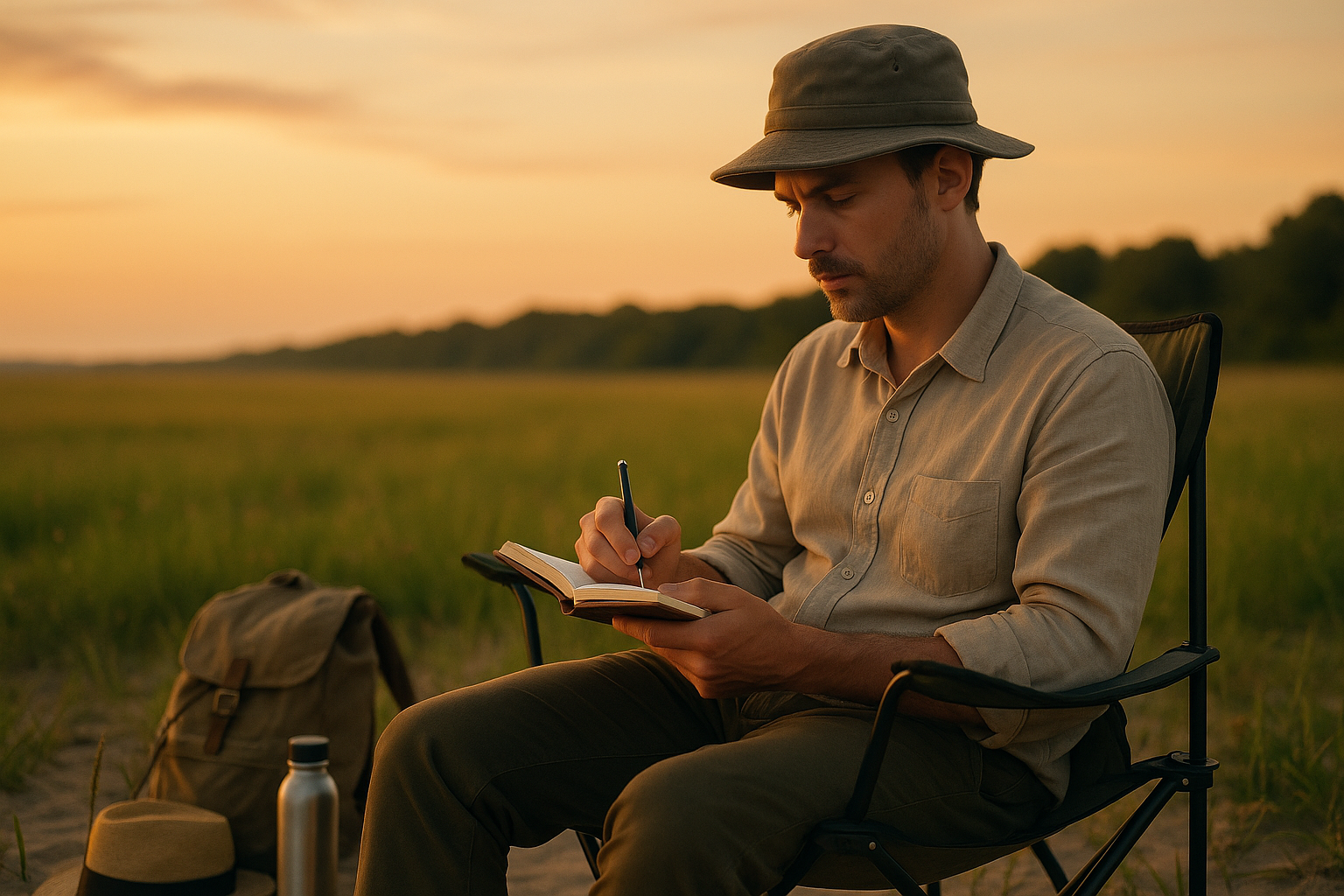While the physical journey can be exhilarating, there is an inherent art to translating those sensory inputs into words, capturing the essence of one’s experiences, and distilling the chaos of travel into structured narratives. This art is often encapsulated in a unique form of self-expression – travel journaling.
Travel journaling, however, is not just about narrating your adventures or jotting down notes about the places you’ve visited. Instead, it is a profound exercise in mindfulness, a tool for cultivating a minimalist mindset, and a conduit for unleashing your wanderlust in its rawest form. The act of penning down experiences, thoughts, and emotions allows us to pause, reflect, and process the journey, adding a layer of depth and meaning that extends far beyond the physical boundaries of our travels.
In this detailed exploration, we will delve into the intricacies of travel journaling and its potential for fostering a minimalist mindset. If you’re yearning to streamline your thoughts, focus on the essentials, and unearth the art of conscious living through your travel experiences, you’re in for an enlightening read.
The Intersection of Travel, Journaling, and Minimalism
At the crossroads of travel, journaling, and minimalism, lies a unique opportunity for self-discovery and personal growth. Travel exposes us to different cultures, environments, and perspectives, providing an abundant source of stimuli and experiences. Journaling, on the other hand, is a potent tool for introspection, reflection, and self-expression. When combined, these elements can yield a transformative impact, enabling us to live more mindfully and embrace a minimalist mindset.
We will explore how journaling during your travels can help declutter your mind, promote a sense of mindfulness, and foster an appreciation for simplicity. We’ll discuss practical strategies for effective journaling, the role of digital tools in modern travel journaling, and how to cultivate habits that enhance the quality and impact of your entries.
Unleashing the Power of the Written Word
Writing is a powerful form of self-expression, a conduit for personal insights, and a catalyst for change. Travel journaling amplifies these benefits, enabling us to document our journey, introspect on our experiences, and learn from our adventures. We’ll explore the transformative potential of travel journaling, discussing how it can foster personal growth, enhance your travel experience, and even improve your writing skills.
Whether you’re a seasoned globetrotter or a novice explorer, a digital nomad or a traditional journal enthusiast, this comprehensive guide aims to equip you with the knowledge, strategies, and tools to harness the full potential of travel journaling for cultivating a minimalist mindset. By the end of this exploration, you’ll be well-versed in the art of journaling your travels, enabling you to transform your adventures into meaningful narratives and embark on a journey towards a more mindful, minimalist lifestyle.
Embracing the Minimalist Mindset Through Travel Journaling
Often, we are so caught up in the hustle and bustle of daily life that we forget to take a moment to enjoy the simple pleasures that life has to offer. One such pleasure is the art of travel journaling, which not only helps us to document our experiences but also encourages a minimalist mindset. By focusing on the essential elements of our travels, we can begin to cultivate a more mindful, minimalist approach to life.
This article will guide you through the journey of travel journaling from a minimalist perspective. It will provide practical tips, compare different journaling methods, and explore the benefits of adopting this rewarding habit. Whether you’re an avid traveler or someone looking to declutter your mind, travel journaling can offer a fresh perspective on your experiences.
For a more visual guide on how to start a travel journal, check out the video “How to Start a Travel Journal” by Wanderlust Worker on YouTube. It offers a step-by-step approach to capturing your travel memories and fostering a minimalist mindset.
Starting Your Travel Journal: Essentials and Tips
Beginning a travel journal is a personal and reflective process. It’s about finding a method that suits your style and mindset. To get started, you’ll need a journal or notebook, a pen, and an open mind ready for exploration.
The first step is choosing your journal. There’s a wide range of options available, from basic notebooks to intricate travel-specific journals. It’s essential to pick something that resonates with you and encourages you to write. Some prefer a minimalist notebook, while others enjoy a more detailed, feature-rich journal.
For a detailed comparison of different types of travel journals, refer to the table below. It provides an overview of various journal options, considering factors like size, layout, and features. This comparison can help you choose a journal that best fits your travel and minimalist needs.
| Type of Journal | Size | Layout | Features |
|---|---|---|---|
| Basic Notebook | Small to Large | Lined, Dotted, or Blank pages | Simple, versatile, can be customized |
| Travel-specific Journal | Medium to Large | Sections for Itinerary, Memories, Photos | Structured, detailed, comes with prompts |
Techniques to Enhance Your Travel Journaling Experience
Travel journaling is more than just recording facts and events – it’s about capturing emotions, observations, and insights. You can enhance this experience by incorporating various techniques into your journaling routine. Here are three methods that you might find useful.
Mindful Writing: Instead of rushing to fill your journal with every detail, practice mindful writing. Take a few moments to absorb your surroundings, then write about the things that truly stand out. This practice aligns with the minimalist approach, focusing on quality rather than quantity.
Sketching and Doodling: If words aren’t enough, try expressing yourself through sketches and doodles. You don’t have to be an artist to do this – the goal is to capture your impressions, however abstract they may be.
Collecting Mementos: Sometimes, a ticket stub or a postcard can evoke memories better than words. Consider attaching these mementos in your journal as tangible reminders of your travels. However, remember to keep it minimal – only collect items that hold significant meaning to you.
The Impact of Travel Journaling on a Minimalist Mindset
Travel journaling and minimalism might seem like two different concepts, but they share a common thread: they both encourage us to focus on what truly matters. Through travel journaling, we learn to value experiences over possessions, a key tenet of minimalism.
Moreover, by consciously choosing what to document in our journals, we exercise our decision-making skills and learn to prioritize. We learn to discern the essential from the trivial. This practice can extend beyond journaling and into our daily lives, helping us adopt a more minimalist mindset.
So, unleash your wanderlust and start your travel journaling journey. Not only will you create a treasure trove of memories, but you’ll also cultivate a minimalist mindset along the way. Remember, it’s not about how much you write or collect, but the quality and meaning behind each entry and memento.
Watch “Minimalist Travel Journaling: Tips & Ideas” by Studyign on YouTube for more inspiration and guidance on how to balance travel journaling with a minimalist lifestyle. Embrace the journey and let travel journaling transform your mindset!

Conclusion
In this comprehensive exploration, we have critically examined the intricate web of IT and engineering concepts, making a concerted effort to demystify their complexities and render them accessible to a wider audience. From the intricate world of programming languages and database systems, to the dynamics of software engineering and the innovative frontier of artificial intelligence, we have embarked on a thrilling journey of exploration and discovery.
We have seen how the fundamental principles of IT and engineering not only underpin our digital world, but also drive innovation and change. The power of programming languages, for example, has been aptly demonstrated, highlighting the pivotal role they play in software development. From Python’s simplicity and flexibility, to the robustness of Java, the uniqueness of each language has been brought to light.
Database systems, on the other hand, have proven their indispensable role in managing and organizing data, laying the foundation for data-driven decision making and informed business strategies. The advent of sophisticated technologies like Machine Learning and AI, meanwhile, have brought a new dimension to this field, enabling us to process and analyze data like never before.
In the realm of software engineering, we have explored its many facets, from the design and development of software, to testing and maintenance. The importance of sound engineering principles has been underscored, affirming their role in creating robust, efficient, and user-friendly software.
Throughout this journey, we have underscored the critical importance of technical proficiency and a solid grounding in these fundamental concepts. The ability to understand and navigate these complex domains is not merely an academic exercise, but a prerequisite for success in the rapidly evolving world of IT and engineering.
While we have covered a vast array of topics in this article, we have merely scratched the surface of this fascinating field. It is our hope that this exploration has whetted your appetite for further study, encouraging you to delve deeper and discover the wonders that await in the world of IT and engineering.
In this era of rapid technological change, staying abreast of the latest developments and understanding their implications is crucial. It is our hope that this article has provided a valuable resource in this regard, enabling you to gain a firmer grasp of these critical concepts and their practical applications.
As we draw this exploration to a close, we invite you to share your thoughts and insights in the comments section below. We also encourage you to share this article with your colleagues and friends, enabling them to benefit from this resource as well.
Lastly, we invite you to apply these concepts in your daily tasks, utilizing them to solve real-world problems and create innovative solutions. As we have seen, the world of IT and engineering is not merely a theoretical construct, but a practical tool that can be harnessed to drive innovation and change.
Remember, the journey of learning never ends, and every step taken is a step closer to mastery. Keep exploring, keep learning, and keep pushing the boundaries of what is possible. The world of IT and engineering awaits!
Thank you for joining us on this exciting journey of exploration and discovery. Until next time, keep exploring, keep learning, and keep pushing the boundaries of what is possible.
For further reading, we highly recommend the following resources:
– [Programming languages](https://www.w3schools.com/)
– [Database Systems](https://www.mongodb.com/what-is-a-database)
– [Software Engineering](https://www.sciencedirect.com/topics/computer-science/software-engineering)
– [Artificial Intelligence](https://www.ibm.com/cloud/learn/what-is-artificial-intelligence)
References:
– W3Schools. (n.d.). Programming languages. Retrieved from https://www.w3schools.com/
– MongoDB. (n.d.). What is a Database? Retrieved from https://www.mongodb.com/what-is-a-database
– Science Direct. (n.d.). Software Engineering. Retrieved from https://www.sciencedirect.com/topics/computer-science/software-engineering
– IBM. (n.d.). What is Artificial Intelligence. Retrieved from https://www.ibm.com/cloud/learn/what-is-artificial-intelligence.



